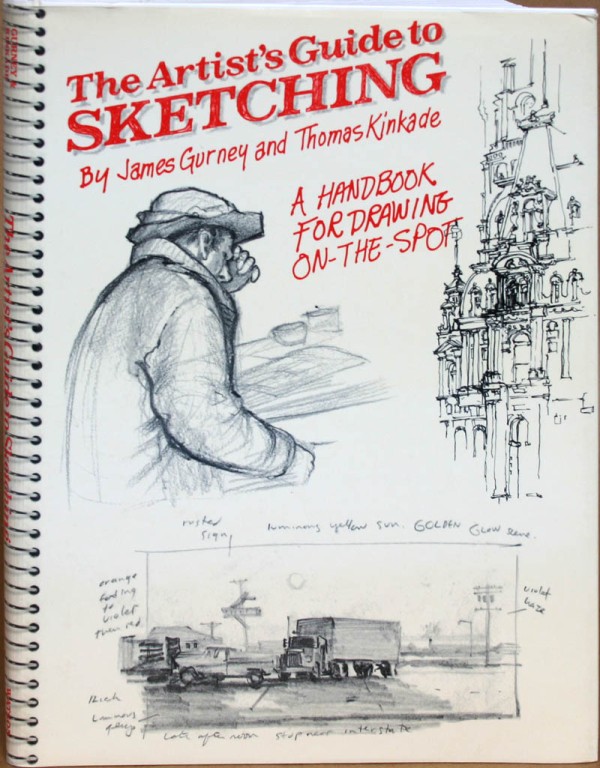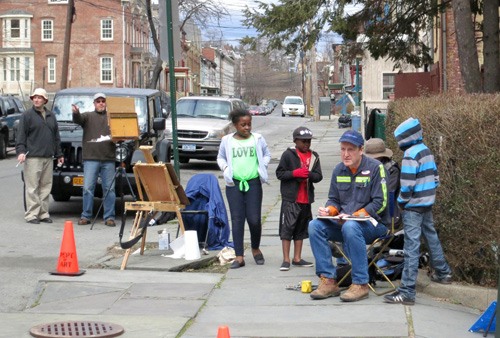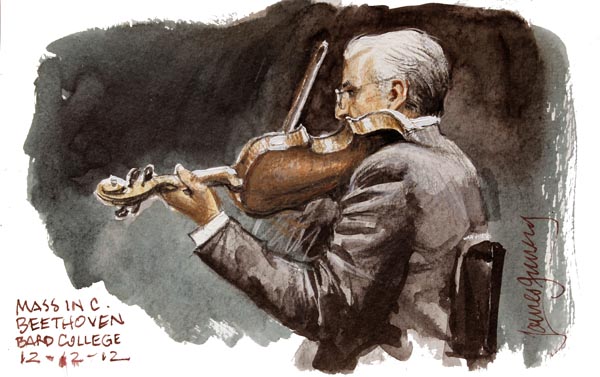By Marc Holmes

Arkell Museum Dinotopia Exhibition
For
many readers, illustrator/artist James Gurney needs no introduction.
His imaginary world Dinotopia has delighted fans of fantastic art, and
inspired artists both young and old for 20 years.
More recently
his well-researched non-fiction guides to realistic painting of
fantastic subjects have become keystones in any illustrator’s library.
It’s safe to say he has been an influence on a generation of
illustrators.
What is perhaps less known, is his passion for painting and drawing on location. He keeps followers of his blog and YouTube channel well up to date on his sketching adventures. I highly recommend subscribing to both.
I recently had the privilege of sketching with
James and Jeanette Gurney, and a group of artists in their
Tri-state/New England coterie. As you’d expect, I found them all to be
knowledgeable art historians, avid sketchers, and all around great
people.
James has graciously agreed to a short interview for Urban Sketchers.org.
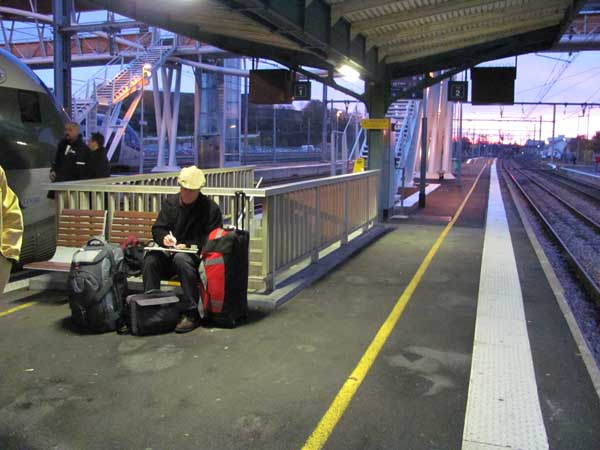
MTH: I asked around if any of our sketchers had a question for you. Here’s one that’s a great opener from Cathy Johnson of Missouri:
“I’ve
loved James Gurney since his very first book, back in the 80s; The
Artist’s Guide to Sketching, with Thomas Kinkade (yes, that
Kinkade–they took different paths!) Two young men taking off to sketch
across America…it’s delightful! “
J.G: Thanks, Cathy! I love your work too, ever since I first saw it in An Illustrated Life.
Tom
Kinkade and I were assigned together as freshmen roommates at UC
Berkeley when we were both 17 years old. Over the years we went on a lot
of sketching adventures together. I knew him long before he became the “Painter of Light.”
We
both went to the same art school, but we left after a couple semesters
because we started getting jobs, and the school wasn’t teaching what we
wanted to learn. Plus, after reading the on-the-road adventures by Jack
Kerouac, Charles Kuralt, and John Steinbeck, we wanted to leave behind
the cramped, windowless classrooms and confront the real world with our
sketchbooks.
We filled our backpacks full of art supplies and hopped on a freight train heading east out of
Los
Angeles. We were too broke for hotels, so we slept in graveyards and
underpasses and we sketched gravestone cutters, lumberjacks, and
ex-cons. To make enough money for food, we drew two-dollar portraits in
bars by the light of cigarette machines.
Here’s a picture of Tom and me wearing matching gas station uniform shirts with our sketchbooks in rural Missouri.
We
made it all the way to Manhattan. We sketched the city by day, and by
night we slept on abandoned piers and rooftops. We had a crazy idea to
write a how-to book on sketching, so we made the rounds of the
publishers. There weren’t many books in print on the subject, other than
the 1976 book “On the Spot Drawing” by Nick Meglin. But our heroes were
older: Menzel, Guptill, Watson, and Kautzky.
We hammered out the
basic plan for the book on paper placemats in a Burger King on the Upper
West Side. We were never completely comfortable with the word
“sketching,” because it implied something that is cursory or casual or
tentative. We wanted to do art from observation that was accurate and
detailed, but more importantly, vital, probing and totally committed.
We
eventually got a contract from Watson-Guptill, and the book was
published in 1982. It is as much about the adventure of sketching on the
road as it is about technique. It’s out of print now, very expensive to
buy. Before Tom died we talked about bringing it back to print again,
but we just got too busy with other projects.
MTH: What effect did that adventure have on your location work?
J.G:
One effect of that trip on both of us was that we developed a healthy
respect for how different people look at artwork. We set up a little
stand at the Missouri state raccoon-hunting championships with the goal
of doing portraits of everybody’s favorite dogs. The owners were very
particular about the dogs’ proportions and markings, and they weren’t
going to pay us the two dollars we were asking unless we got the details
right. It was a tougher critique than we ever got in art school.
MTH:
As a follow up to that, you are well known for your works of fantastic
art, and your vivid realizations of ancient history (I’m thinking of the
National Geographic work). These seem like ideal subjects for a
illustrator– depicting things that no longer (or never did) exist – but
making them as real as possible. As an Urban Sketcher, naturally I
wonder how much of this you credit to your background sketching? What’s
the relationship between observing the world and visualizing your
imagination?
J.G:
Yes, the inner eye and outer eye. The two are inseparable. A few times I
got to travel on research assignments for National Geographic with the
art director J. Robert Teringo, who was also a fanatic for sketching and
a graduate of the Famous Artist’s School.
We
brought our watercolors to Israel and Jordan and Petra while
researching an archaeology story about Palestine during the time of the
Caesars. I brought a camera, too, but the location studies were more
useful. It wasn’t hard to imagine the clock turning back to a time
before photography was invented, when artists were necessary members of
archaeological expeditions.
You
mention fantasy work. I’m probably best known for writing and
illustrating Dinotopia, the book about a world where humans and
dinosaurs coexist. Dinotopia’s whole premise is that of a 19th century
explorer named Arthur Denison documenting a new world with his
sketchbook. The idea for Dinotopia came directly from my on-the-road
sketching days with Kinkade and my field research sketching for National
Geographic.
MTH:
Would you say that all of your major works have some element of field
study? Which happens more often – an idea for an imaginative work that
requires you to make field studies, or a sketch on location that
inspires a studio painting?
It goes
both ways. Sketching from life definitely builds my visual vocabulary,
which helps when I’m trying to conjure a fantasy world from thin air. I
often dig into my sketchbooks for poses, rock formations, trees,
landscape effects, or other details. That’s one of the reasons I like to
draw everything. As Adolph Menzel put it: “alles Zeichnen ist nützlich,
und alles zeichnen auch” (“All drawing is useful, and to draw
everything as well.”)
MTH:
You seem to enjoy using sketching to get behind-the-scenes access. To
put yourself in front of out-of-the-ordinary subjects many of us might
never get to sketch. What are some of the most exotic places location
sketching has taken you? When you plan these missions, how do you select
a worthwhile subject? What makes your list of “must draw” places? Any
advice for Urban Sketchers on how to make these adventures happen?
Rather
than retell stories that I’ve told on the blog, why don’t I just
mention a few experiences, and people can follow links to a fuller
description.
[Crescent wrench factory]
[Dangerous neighborhoods]
[Boat in Shanghai]
[Monkeys in Gibraltar]
MTH: There’s plenty more! James’ blog is encyclopedic. Some places exotic, some more commonplace.
The Metropolitan Opera | Gorillas at the Zoo | Nursing Home | Antique Dealer, Tangier | Car Dealership | Laundromat | Supermarket Loading Dock
J.G.:
I have no list of must-draw places. I’m usually not interested in
art-workshop destinations in Tuscany or touristy places that are overrun
with artists. I prefer non-motifs, the little beauties that everyone
passes by. The sketches that mean the most to me are closest to my own
life. I love what Andrew Wyeth did by staying within a very narrow
perimeter.
MTH:
In the Urban Sketching community we have a kind of ‘aesthetic
agreement’ that we are all sketching from first hand observation. (At
least, what we choose to post on these pages). Mostly this is because we
enjoy the idea of getting out and seeing the world. But it can lead to
an assumption that drawing from life is always superior to drawing from
reference. We started to touch on this topic on our sketching outing,
but didn’t get too far in. I get the impression you don’t use much
photographic reference, or try to avoid it when possible. Is that
generally true? How do you feel about all that – the from life vs. from
photography question?
J.G.: I love
photography and I use photographic reference in my studio work. But keep
in mind that my specialty is painting realistic images of things that
can’t be photographed. Photos only get you part way there. For that
work, I build maquettes and get people to pose and look at reference.
But what I’m actually visualizing is something that is altogether beyond
the reach of a camera, such as a dinosaur, an ancient Roman, or a mech
robot.
When I’m outdoors sketching from observation, my goals are
very different. I’m trying to catch life on the run. I love the
challenge of trying to record changing light and moving subjects.
[Mass in C]
The
sense of urgency that it induces in me forces me to improvise and act
on intuition. There would be no reason for me to take photos on location
and work from them in the studio, because that exercise would have no
purpose and would hold no interest for me.
MTH: So, your YouTube channel is pretty awesome!
Your
mini-documentaries of your sketching outings are quite sophisticated –
voice over, multiple cameras, establishing footage, even tracking shots.
And you’re very generous with the amount of content.
It
must take a lot of mental energy, juggling between doing the artwork
and operating multiple cameras. Can I just outright ask – what makes all
of that worthwhile? You’re a rare example, an artist who chooses to do
all that on location. Many of us would find it terribly distracting. Yet
you are able to make excellent drawings, and be a documentary filmmaker
at the same time. (Not that I am trying to get you to stop – please do
keep making these films).
J.G.: Thanks.
Why do I do it? I grew up in a family with no artists, I didn’t take art
classes, and I was kind of a loner. So all through my youth, I never
got to watch anyone else drawing or painting from life.
Once I
arrived at art school and started meeting other artists, I was
completely captivated with how other people made a picture. And I was
fascinated to learn what they were thinking about as they did so.
I
believe that drawing from observation is an intensely magical act, like
a form of conjuring. What I’m trying to do with my videos is to try to
bottle that magic, to catch the fish and tell the fish story at the same
time.
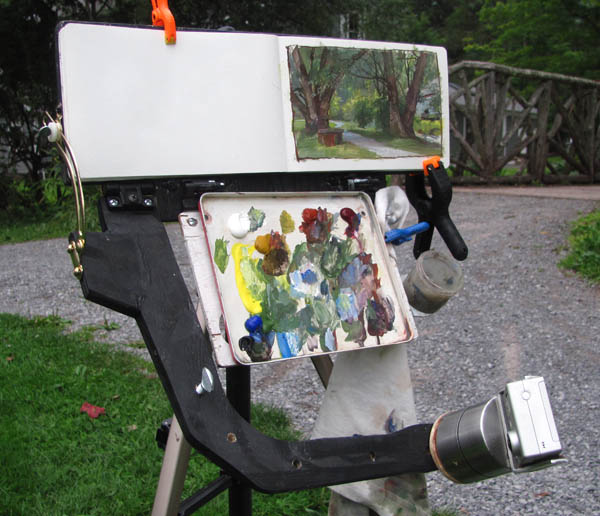
[Sketchbook Pochade – Note Gopro Hero attached to egg timer. Some Yankee ingenuity at work.]
Yes,
it takes a good deal of focused attention to document a sketch while
I’m making it. Sometimes I get so wrapped up in a piece that I forget to
get good coverage.
But a separate film crew can’t get the kind of
coverage I’m after. They’re always on the outside looking in. In my
videos, I not only want to show the viewer what I’m doing close up, but
also to let them inside my head so they can see what I’m thinking.
The
other answer to what makes it worthwhile is that over the next few
years I will be building a library of instructional videos for sale
showing in detail how I use various media and how I solve various
problems.
In 2014 I will be releasing a video on watercolor painting on location, followed by other plein-air media.
MTH:
Do you have some tips for a sketcher who wants to capture their own
work on video? Some good introductory gear, or reliable techniques.
J.G.: Let’s start with techniques—Basic tips for shooting video of urban sketching:
1. If you’re a beginner, use a tripod and NEVER pan or zoom.
2.
Get coverage. Shoot a lot of four second clips. It really helps to have
a nice range of shots: an establishing shot, some closeups, some
palette or pencil box shots, time lapse, reaction shots of people around
you, plus a shot of the motif that you’re looking at. Get some audio
background sounds and add voiceover later if you don’t want to narrate
what you’re doing in real time. Editing is much easier if you’ve got
good coverage, and it’s frustrating for the viewer if you don’t.
3. Get a camera with manual controls, esp: focus lock, custom white balance, and manual exposure control, and learn to use them.
4.
You can use a basic editing program like iMovie. Edit your footage down
as much as possible. Art in real time, like life in real time, is
boring. It only gets exciting when it’s well edited.
Gear:
1.
I use relatively inexpensive gear: a Canon Vixia HF R40 camcorder, a
Canon T3i digital SLR, and a GoPro Hero2, with audio recorded on an H1
Zoom. I purchased all that gear for around $1,000.
2. All the
dolly rigs and motion control rigs are super cheap DIY workshop projects
using Legos and broomsticks and stuff like that.
3. I learned
about video shooting and editing techniques from watching YouTube
tutorials online. I shoot and edit all my own stuff.
MTH:
Orling Dominguez of the Dominican Republic wanted me to ask about your
technical process. You have an interesting mixed media approach, open to
any tool or technique you can combine. What are you thinking as you
bring all these different materials together? Have you developed a
step-by-step process to your choices, or is it more ‘by feel’? What
makes something suited for one approach over another?
J.G.:
Good question, Orling. In my urban sketching kit, I bring art supplies
that are totally cross-compatible: a fountain pen, water-soluble colored
pencils and graphite pencils, water brushes (one with water and a
couple others with water-soluble colored inks), a small Schmincke
watercolor pan set, and a few tubes of gouache. I also have an oil
painting kit and a casein kit.
[What’s in my bag?]
Basic
thinking: there is no line between drawing and painting, and there are
no “purist” rules. Anything goes as long as it’s conservationally sound.
I use whatever media or methods convey the most information or mood in
the time available. And of course, I only bring out what is reasonable
to use in a given situation, such as a concert hall, a subway, or a
restaurant.
[Plein Air Monterey]

[James’s watercolor gear. Not afraid to be an art nerd I see. I kid! We are all the same.]
MTH:
I’m always interested if an artist has a philosophy about this: What
makes something a sketch vs. a painting? Is that line so blurry you
don’t even worry about it any longer?
I don’t place any
boundaries between a sketch and a finish, or between a drawing and a
painting. I like the word “study” because it implies a more carefully
observant and patient mindset, but a work done as a study from life can
have the power and detail of a finished work as well. A study is not
necessarily a means to an end. But since we have to call our works
something when we refer to them, we’re stuck with the limitations of the
lexicon.
MTH:
You have always been an example to other artists of a self-taught,
highly motivated individual who is doing their own thing. Given that, I
think this is a great closing question from Nina Johansson from
Stockholm:
“I
assume that Gurney lives off of his art, and it would be interesting to
get some hands-on advice for others who dream of doing that. We have
been having this discussion at the school where I work, about how
artists are usually not great at doing business, and how we would like
to give our art students some classes in how to run a small business to
be able to make a living – only the curriculum gets in the way. We’ll
see how it goes, but in the meantime I like to show them good examples.
:)”
If
I can just add to that: I’m assuming at this stage of your career, you
can pretty much do what you want, pick your projects. What do you see as
the most interesting ventures for artists in the next decade?
[Highland Avenue]
Thanks,
yes, it’s true, I’ve always lived off the brush and I’ve always painted
what I want. Some years a lot of money rolls in; other years I make
less than the janitor. But I’ve always been happy and followed my muse.
[Mud Puddle]
I
believe every art student should get schooling in business: marketing,
contracts, accounting, publicity, and especially in this age of
creator-producer, it’s important to know about distribution, and sales.
If art schools don’t offer this, you can pick it up on your own. I’m
always trying to learn new things about how to make what I love to do
pay for my living.
That said, I try to keep business
considerations from driving what I do or how I do it. I just want to
have fun doing the very best quality work I can. I’m glad that the
internet lets me share what I produce and what I learn with others. I
have faith that enough people will support me to keep me doing it.
[Bleecker and 11th]
Sketching
from life is making big strides forward, both with the Urban Sketchers
and the plein-air-painting movements. Some people make a living doing
these things, but that’s not why they’re important. People who sketch in
their spare time from other jobs, and professionals who do it for
relaxation or learning are just as important to the movement.
Working
directly from nature has always brought fresh blood into Art, and we’re
all lucky to be living in the midst of this revival.
MTH:
Well, thanks for all your generous time – you’ve given us great
answers, it’s been really excellent having you! Hope to see you
sketching on the street. If you’re ever on the road, feel free to look
up the local Urban Sketchers group wherever you are.



